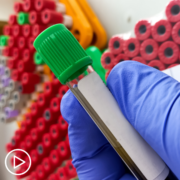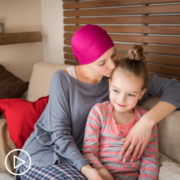An Overview of Metastatic Breast Cancer Treatment Options from Patient Empowerment Network on Vimeo.
What metastatic breast cancer (MBC) treatment options are available? Dr. Jane Lowe Meisel provides an overview of MBC treatment approaches, including CDK4-6 inhibitors, tyrosine kinase inhibitors, PARP inhibitors, and immunotherapy.
Jane Lowe Meisel, MD is an Associate Professor of Hematology and Medical Oncology at Winship Cancer Institute at Emory University. Learn more about Dr. Meisel here.
See More From INSIST! Metastatic Breast Cancer
Related Resources:
Transcript:
Katherine:
Right.
Well, let’s talk about treatment options for advanced disease. Can you review the types of treatments available for metastatic breast cancer?
Dr. Meisel:
Absolutely. And what I’ll do is, I’ll give you a broad overview and then because there’s so much and this is such a rich environment, I mean, I give hour long lectures just about the treatment of metastatic triple-negative breast cancer to our fellows. So, there is so much meaty information here. But I’ll give an overview with some key buzzwords so then people can go look up things that matter more to them or interest them more. So, as I said, we start with thinking about, is this hormone receptor-positive or estrogen-positive breast cancer? Is this HER2-positive or is this triple-negative? And those factors really send us down different paths.
So, if someone is estrogen-positive, I had mentioned before the PALOMA and MONALEESA studies showing that CDK4-6 inhibitors, which is a class of drugs that the first one was approved in 2015 and then two others have been approved subsequently. So, relatively new drugs. But those drugs, which are pills, added to traditional anti-estrogen therapy which would be aromatase inhibitors or fulvestrant.
Are often great first line options for these patients. And people can do well for years on just that alone, with estrogen-positive metastatic breast cancer. On average, about two years before people progress and need something new. And then after that, there are lots of trials ongoing looking at different ways in which an estrogen-positive breast cancer might progress on that regimen and how do we target that. So that there are multiple other anti-estrogen options down the line that people can use in estrogen-positive breast cancer before they need to even think about going on to something like chemotherapy.
So, really lots and lots of options for those patients, but probably starting with a CDK4-6 inhibitor plus anti-estrogen combination. And then in HER2-positive breast cancer, typically the first line treatment would be what we call monoclonal antibodies directed at HER2. So, something like Herceptin and Perjeta, which you may have heard of. And often combined with chemotherapy. But again, this is one of those areas that is also very, I think the art of medicine is very important and patient dependent.
Some of these regimen depend a little bit on patient’s age and other medical problems and desires, whether to include chemotherapy along with that frontline anti-HER2 regimen. Or whether to think about something like anti-estrogen therapy if the patient is HER2-positive and estrogen-positive. And then there are a lot of other different things we’re also using in HER2-positive disease after patients progress on that initial therapy, so there are what we call, antibody drug conjugates, where a chemotherapy like drug is attached to an antibody that then brings the chemo to the HER2-positive cell and allows for chemotherapy penetration more directly.
And then a class of drugs called tyrosine kinase inhibitors, which are oral drugs that get directed at HER2. So, another really exciting area to treat and a place where we’ve seen so many advances. And then in triple-negative breast cancer, I’d mentioned that chemotherapy has really been the mainstay of treatment historically because there weren’t great targets. But recently we’ve seen that immunotherapy, along with chemotherapy drugs like Keytruda, which you may have heard of.
Or atezolizumab, which is Mesenteric, can be used along with chemo and patients that overexpress a molecule called, PDL1. And that can actually include not just how long patients spend on the first treatment, but how long they live. So, we’re seeing a lot of triple-negative patients being great candidates for immune-based regimens now. And then for patients who have inherited a BRCA gene mutation, which many of you may have heard of. That gene mutation can actually predispose a triple-negative patient to be more receptive to a class of drugs called PARP inhibitors.
So, drugs like Olaparib or Talazoparib are new drugs that’ve been approved in the last couple of years in triple-negative metastatic breast cancer for patients who carry a BRCA1 mutation or BRCA2 mutation. And then there are also antibody drug conjugates in triple-negative breast cancer as well. The Trodelvy that’s been approved and then of course others that are in clinical trials currently. So, as you can see, it’s complex. I mean, the treatment of metastatic breast cancer is complicated. And so, it’s important I think to really be able to have a dialogue with your provider about what they’re recommending for you and why.
And I think there are often lots of options. And so, as much as you can make your doctor aware of what matters to you in terms of what side effects are you most afraid of or would you like most to avoid, what dosing schedules would be idea for your schedule for the rest of your life. So that you can deal with taking kids to school or the job that you’re currently working on or whatever, I think helps your doctor help you come up with the right regimen for you.












